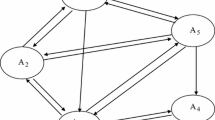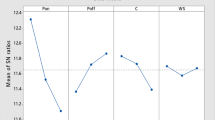Abstract
This paper presents a methodology to evaluate the performance of carbide compacting die using graph theoretic approach (GTA). Factors affecting the die performance and their interactions are analysed by developing a mathematical model using digraph and matrix method. Permanent function or die performance index is obtained from the matrix model developed from the digraphs. This permanent function/index value compares and ranks the factors affecting the die performance. It helps in selection of optimum process parameters during die manufacturing. Hence, process output errors such as dimensional inaccuracy, large surface craters, deep recast layers, etc. will be minimised during die manufacturing which helps to achieve better die performance. In present illustration, factors affecting the performance of carbide compacting die are grouped into five main factors namely work material, machine tool, tool electrode, geometry of die and machining operation. GTA methodology reveals that the machine tool has highest index value. Therefore, it is the most influencing factor affecting the die performance. In case of die material low cobalt concentration and small grain size yields good surface finish, while in machine tool low discharge energy (i.e. low values of peak current, pulse-on time, servo voltage and high value of pulse-off time) and high dielectric flow rate yields good surface finish and, hence, favours the good die performance. In case of die geometry, large work piece thickness and small taper angles results in lesser geometrical deviations and hence helps to achieve better die performance.
Similar content being viewed by others
References
Rao RV, Gandhi OP (2002) Digraph and Matrix methods for the machinability evaluation of work materials. Int J Mach Tools Manuf 42:321–330
Choi KK, Nam WJ, Lee YS (2008) Effects of heat treatment on the surface of a die steel STD11 machined by W-EDM. J Mater Process Technol 201:580–584
Deo N (2000) Graph theory with application to engineering and computer science. Prentice Hall, New Delhi
Gandhi OP, Agrawal VP (1992) FMEA—A Digraph and matrix approach. Reliab Eng Syst Saf 35:147–158
Gandhi OP, Agrawal VP (1994) A digraph approach to system wear evaluation and analysis. Trans ASME 116:268–274
Grover S, Agrawal VP, Khan IA (2004) A Digraph Approach to TQM Evaluation in an Industry. Int J Prod Res 42(19):4031–4053
Rao RV, Gandhi OP (2002) Failure cause analysis of machine tools using digraph and matrix methods. Int J Mach Tools Manuf 42:521–528
Liu K, Li XP, Rahman M (2003) Characteristics of high speed micro cutting of tungsten carbide. J Mater Process Technol 140:352–357
Lauwers B, Liu W, Eeraerts W (2006) Influence of the composition of WC-based cermets on manufacturability by Wire-EDM. J Manuf Processes 8(2):83–89
Kim CH, Kruth JP (2001) Influence of the electrical conductivity of dielectric on WEDM of sintered carbide. KSME Int J 15:1676–1682
Poros D, Zaborski S (2009) Semi-empirical model of efficiency of wire electrical discharge machining of hard-to-machine materials. J Mater Process Technol 209:1247–1253
Lee SH, Li XP (2003) Study of the surface integrity of the machined workpiece in the EDM of tungsten carbide. J Mater Process Technol 139:315–321
Saha P, Singha A, Pal SK (2008) Soft computing models based prediction of cutting speed and surface roughness in wire electro-discharge machining of tungsten carbide cobalt composite. Int J Adv Manuf Technol 39:74–84
Huang JT, Liao YS, Hsue WJ (1999) Determination of finish-cutting operation numbers and machining parameters setting in wire electrical discharge machining. J Mater Process Technol 87:69–81
Grover S, Agrawal VP, Khan IA (2006) Role of human factors in TQM: a graph theoretic approach. Bench Mark Int J 13(4):447–468
Kulkarni S (2005) Graph theory and matrix approach for performance evaluation of TQM in Indian industries. The TQM magazine 17(6):509–526
Mukhopadhyay SK, Ramesh Babu K, Sai KVV (2000) Modified Hamilton chain: a graph theoretic approach to group technology. Int J Prod Res 38:2459–2470
Venkatasamy R, Agarwal VP (1995) System and Structure analysis of an automobile vehicle—a graph theoretic approach. Int J Veh Des 16:477–505
Wani MF, Gandhi OP (1999) Development of maintainability index for mechanical systems. Reliab Eng Syst Saf 65(3):259–270
Mahapatra SS, Patnaik A (2007) Optimization of wire electrical discharge machining (WEDM) process parameters using Taguchi method. Int J Adv Manuf Technol 34:911–925
Puri AB, Bhattacharyya B (2005) Modeling and analysis of white layer depth in a wire-cut EDM process through response surface methodology. Int J Adv Manuf Technol 25:301–307
Sarkar S, Mitra S, Bhattacharyya B (2006) Parametric optimization of wire electrical discharge machining of γ titanium aluminide alloy through an artificial neural network mode. Int J Adv Manuf Technol 27:501–508
Prohaszka J, Mamalis AG, Vaxevanidis NM (1997) The effect of electrode material on machinability in wire electro-discharge machining. J Mater Process Tech 69:233–237
Herrero A, Azcarate S, Rees A, Gehringer A, Schoth A, Sanchez JA (2008) Influence of force components on thin wire EDM. Multi-material micro manufacture. Cardiff University, Cardiff
Puri AB, Bhattacharyya B (2003) An analysis of the geometric inaccuracy due to wire lag phenomenon in WEDM. Int J Mach Tools Manuf 43:151–159
Puri AB, Bhattacharyya B (2003) Modeling and analysis of the wire tool vibration in wire-cut EDM. Int J Mater Process Technol 141(3):295–301
Plaza S, Ortega N, Sanchez A, Pombo I, Mendikute A (2009) Original models for the prediction of angular error in wire-EDM taper cutting. Int J Adv Manuf Technol 44(5–6):529–538
Shichun D, Xuyang C et al (2009) Analysis of kerf in micro-WEDM. Int J Mach Tools Manuf 49:788–792
Sarkar S, Sekh M, Mitra S, Bhattacharyya B (2008) Modeling and optimization of wire electrical discharge machining of γ-TiAl in trim cutting operation. J Mater Process Technol 205:376–387
Jurkat WB, Ryser HJ (1966) Matrix factorization of determinants and permanents. J Algebra 3:1–27
Author information
Authors and Affiliations
Corresponding author
Rights and permissions
About this article
Cite this article
Jangra, K., Grover, S. & Aggarwal, A. Digraph and matrix method for the performance evaluation of carbide compacting die manufactured by wire EDM. Int J Adv Manuf Technol 54, 579–591 (2011). https://doi.org/10.1007/s00170-010-2956-0
Received:
Accepted:
Published:
Issue Date:
DOI: https://doi.org/10.1007/s00170-010-2956-0




